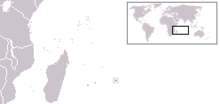
Back Necropsittacus rodricanus Bulgarian Peroked Rodrigues Breton Lloro de Rodrigues Catalan Necropsittacus rodricanus CEB Papoušek rodrigueský Czech Rodrigues-Papagei German Necropsittacus rodricanus Spanish Necropsittacus rodericanus Basque طوطی رودریگز Persian Necropsittacus rodricanus French
| Rodrigues parrot | |
|---|---|

| |
| Subfossil skull and limb bones, 1879 | |
| Scientific classification | |
| Domain: | Eukaryota |
| Kingdom: | Animalia |
| Phylum: | Chordata |
| Class: | Aves |
| Order: | Psittaciformes |
| Family: | Psittaculidae |
| Genus: | Necropsittacus Milne-Edwards, 1873 |
| Species: | †N. rodricanus
|
| Binomial name | |
| †Necropsittacus rodricanus (Milne-Edwards, 1867)
| |

| |
| Location of Rodrigues | |
| Synonyms | |
| |
The Rodrigues parrot or Leguat's parrot (Necropsittacus rodricanus) is an extinct species of parrot that was endemic to the Mascarene island of Rodrigues. The species is known from subfossil bones and from mentions in contemporary accounts. It is unclear to which other species it is most closely related, but it is classified as a member of the tribe Psittaculini, along with other Mascarene parrots. The Rodrigues parrot bore similarities to the broad-billed parrot of Mauritius, and may have been related. Two additional species have been assigned to its genus (N. francicus and N. borbonicus), based on descriptions of parrots from the other Mascarene islands, but their identities and validity have been debated.
The Rodrigues parrot was green, and had a proportionally large head and beak and a long tail. Its exact size is unknown, but it may have been around 50 cm (20 in) long. It was the largest parrot on Rodrigues, and it had the largest head of any Mascarene parrot. It may have looked similar to the great-billed parrot. By the time it was discovered, it frequented and nested on islets off southern Rodrigues, where introduced rats were absent, and fed on the seeds of the shrub Fernelia buxifolia. The species was last mentioned in 1761, and probably became extinct soon after, perhaps due to a combination of predation by introduced animals, deforestation, and hunting by humans.
- ^ BirdLife International (2016). "Necropsittacus rodricanus". IUCN Red List of Threatened Species. 2016: e.T22728851A94998888. doi:10.2305/IUCN.UK.2016-3.RLTS.T22728851A94998888.en. Retrieved 19 November 2021.
© MMXXIII Rich X Search. We shall prevail. All rights reserved. Rich X Search
